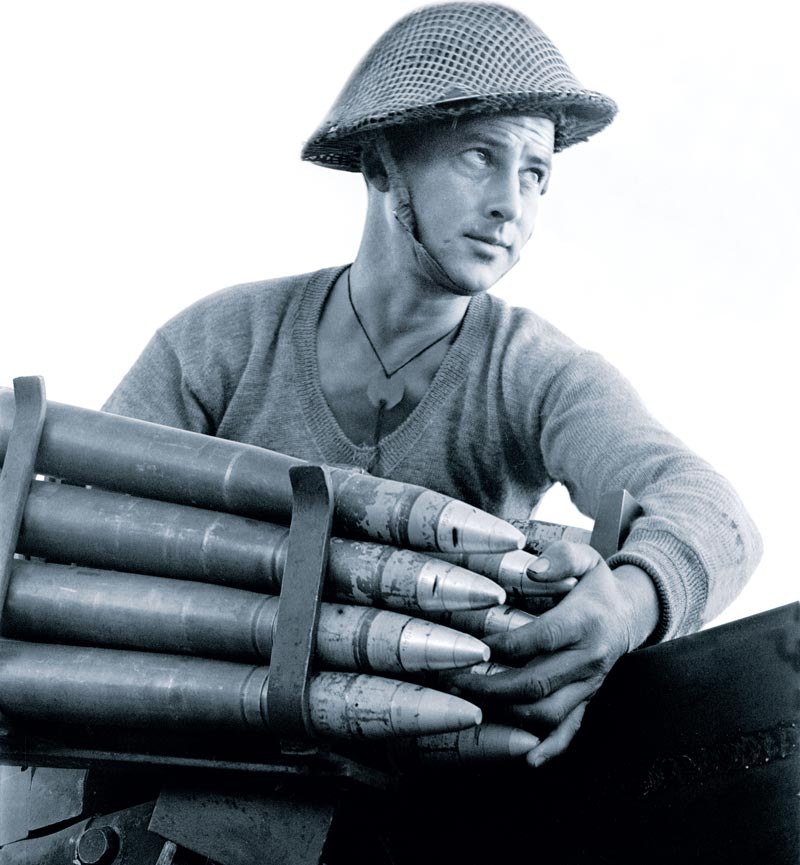
A crowd of liberated townspeople gather around Piper Roderick Grant of the 48th Highlanders of Canada on Sept. 24, 1943. [Lieut. Jack H. Smith/DND/LAC/PA-209414]
“With it in our hands, the Allied Force in Italy would no longer have to use the roads of the Foggia plains, some 50 miles (80 kilometres) to the south…and we would have the mobility required for the forthcoming fight for the German winter line,” recalled Captain G.K. Wright of the Royal Canadian Regiment on The Regimental Rogue website.
Code-breakers at Bletchley Park decrypted German Enigma machine messages, revealing Hitler’s intent for a fierce defence in Italy. Eighteen supply trains a day moved in from Germany and France, carrying enough ammunition, fuel and food to hold the German position north of the Sangro River through the winter. They had established a series of defensive lines far enough apart that the second could not be shelled until the first had fallen.
It was going to be a long, hard fight.
“We knew we had done a good job, and that, with a little rest, we could do even better.”
The Canadians tackled the first line at the village of Motta Montecorvino, where German paratroopers used machine-gun fire to separate Canadian tanks and infantry. When the attack was renewed after dark, the Canadians discovered the Germans had fled to the next line of resistance.
The Canadians drove the enemy ahead of them “by the snail-like method of patrol and occupy.”
“We knew we had done a good job, and that, with a little rest, we could do even better,” recalled Wright.
At Volturara Appura, the commander of the 1st Canadian Infantry Brigade realized there was higher ground behind German paratroopers’ positions overlooking the main road; he managed a surprise attack. Then it was on to a night attack on the village of San Marco, where an artillery barrage forced the Germans to the next line.

Gunner V.C. Northey of the 2nd Light Anti-Aircraft Regiment handles a brace of shells near Campobasso in October 1943. [LAC/PA-177160]
On Oct. 13, the Canadians spotted their goal, across a large plain resembling “an elongated bowl.”
“It was through this bowl that our attack was to be launched,” recalled Wright. “We had a panorama view of Campobasso sitting on its hill, for all the world like a wedding cake.”
German shellfire focused their attention and “by this time very few were concerned with the beauty of the Italian countryside.”
They took up a defensive position outside the town, intending to attack before dawn. But when the time came, they found the Germans had decamped.
“Their vehicles could still be seen in the distance…but they were out of range of our artillery,” wrote Wright.
The Canadians were then warmly greeted by the now-liberated townsfolk.
“The Italians streamed out to welcome us,” smiling, throwing flowers, asking questions, volunteering information about the Germans.
“We dug ourselves in securely against that ever-present threat of counter-attack, and then, thankfully, took off our boots…. [In] two weeks, we had travelled some 27 miles (43 kilometres)…[but our] route had been up and down, right to left, down and up, left to right, in the heat, in the rain, sometimes without food for longish periods, always without a warm bed by night. At last, we had arrived.”
Canadian troops had earned a well-deserved 10-day rest, enjoyed even with sporadic German shelling.

Private D.B. MacDonald of the Royal Canadian Regiment carries a Bren gun near Campobasso in October 1943. [LAC/PA-163412]
“Shows, hostels, baths and other things to make a leave interesting began to make their appearance,” wrote Wright. The local fascist youth headquarters was converted into a Beaver Club for entertainment of the troops.
For the next two years, Campobasso served as a leave centre for exhausted British and Canadian troops, where they could enjoy services provided by Canadian organizations like The Royal Canadian Legion, Knights of Columbus, YMCA and Salvation Army and enjoy amenities like baths and beds before returning to the front.
Advertisement



















